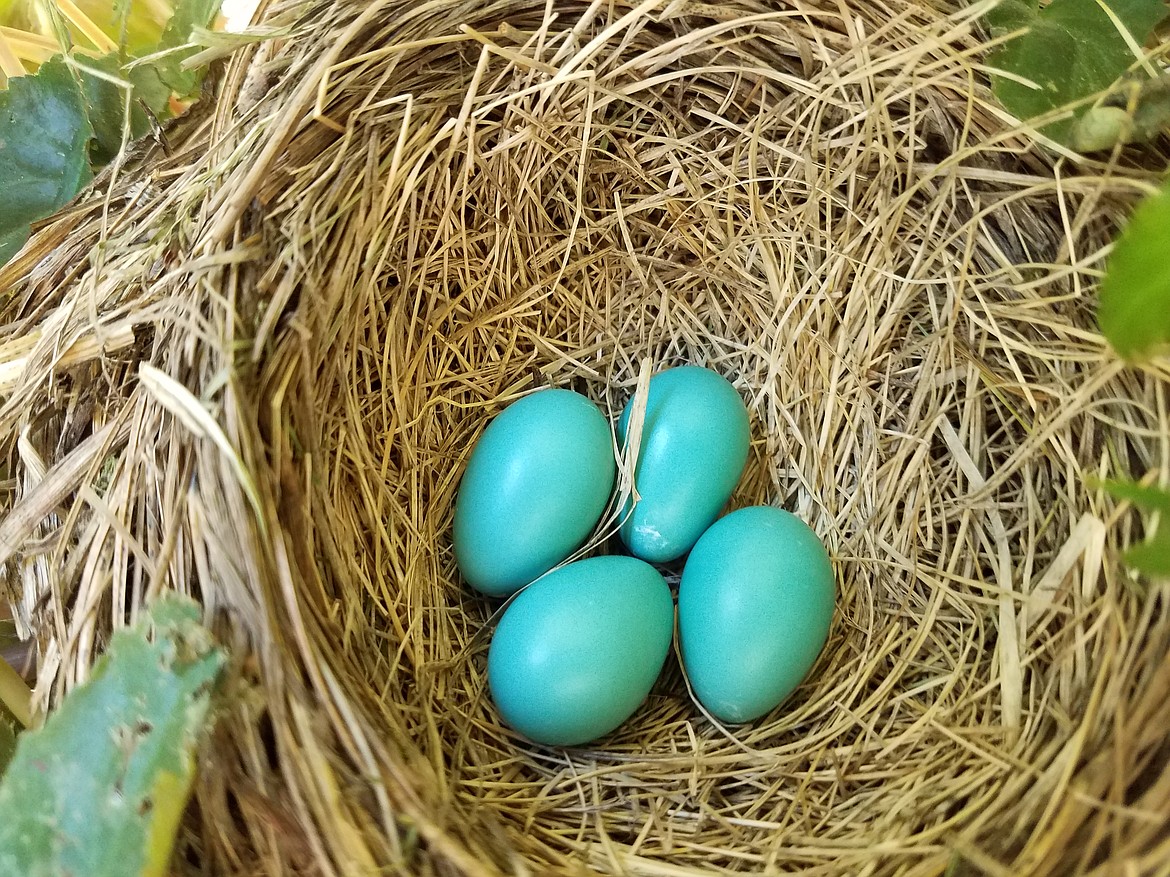Robin eggs: Sky blue with tomorrow inside!
Don Bartling Contributing Writer | Hagadone News Network | UPDATED 7 years, 6 months AGO
Last week I was delighted to see a robin come back to our yard and claim a hanging begonia on our front porch as she did last year. A few days later I climbed on a step ladder and saw three beautiful blue eggs in the nest. A couple days later I checked and she had laid another egg, typical of robins as four eggs are their usual clutch.
The robin early birds catch worms, then they lay eggs. Most birds lay their eggs at sunrise, but not robins! They lay their eggs at mid-morning. That’s several hours later than most birds lay eggs. For robins, this makes good sense. Robins eat a lot of earthworms and they use those early dark hours to hunt for worms because worms are most available before the sun gets too high. After feasting on worms a robin can easily fly to her nest.
Robins usually lay four eggs and then stop. Like most birds, they lay one egg a day until their clutch is complete. If you remove one egg each day, some birds will keep laying for a long time, as if they can stop laying only when the clutch of eggs feels right underneath them.
Until they’ve laid a full clutch, robins allow all the eggs to stay cool so the babies don’t start to develop. That’s pretty smart! It means all the babies hatch close to the same time. Mother robins may start incubating their eggs during the evening after the second egg is laid, or after all the eggs are laid. They sit on the eggs for 12 to 14 days. The female usually does all the incubating. Even in good weather, she rarely leaves her eggs for more than 5 to 10 minutes at a time.
It’s mom’s job to maintain the proper incubation temperature, keeping the eggs warm during cold weather and shaded during really hot weather. She also must turn or rotate the eggs several times daily. She hops on the rim of the nest and gently rolls the eggs with her bill. Turning the eggs helps keep them all at the same temperature and prevents the babies from sticking to the insides of the eggshells. Males only occasionally sit on the eggs, but they patrol in the territory throughout the daylight hours and respond immediately if the female gives a call of alarm. A male may even bring food to feed his mate, but usually she leaves the nest to feed herself.
Fighting its way out of the egg isn’t easy for a chick. First it breaks a hole in the shell with its egg tooth, a hard hook on its beak. Then it must struggle with all its might, between periods of rest, to get out. No wonder hatching may take a whole day. The eggs usually hatch a day apart in the order they were laid. Naked, reddish, wet and blind, the babies require a lot of food. Now it becomes a full time job for both parents to protect the nest, find food, and feed the clamoring babies during the 9-16 days they spend in the nest.
My wife and I are anxious for the next few days to pass until the eggs hatch and we hear the chirping of four baby robins.
Enjoy the beauty of Boundary County and its birds!
ARTICLES BY DON BARTLING CONTRIBUTING WRITER

About the Douglas fir
“The big tree is nature’s forest masterpiece, and so far as I know, the greatest of living things.” — John Muir 1838-1914 “Father of the National Parks” and author.

Winter on the hoof: How deer, elk and moose cope with the snow!
“When snow falls, nature listens.”


